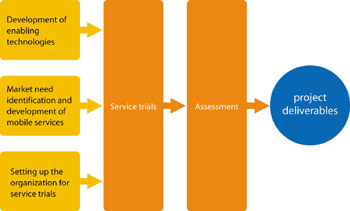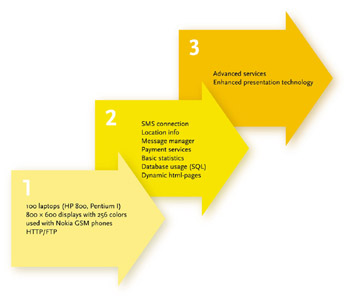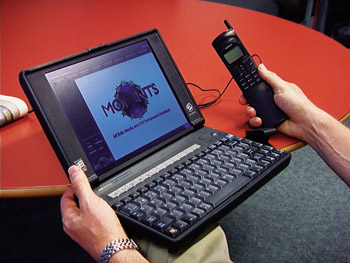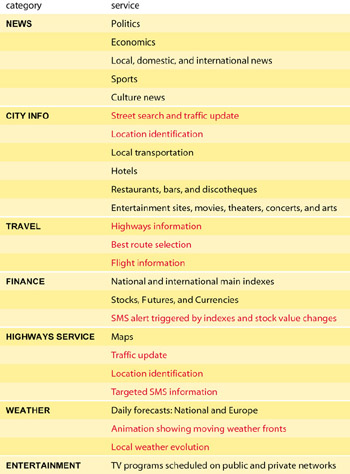The MOMENTS Project
|
|
MOMENTS (Figure 10.1) was launched as a joint effort between all stakeholders of the mobile multimedia value chain. Our partners included content and service providers, telecommunication operators, network and terminal manufacturers, financial institutions, and multimedia technology research centers. The project objective was to demonstrate the technical feasibility and business viability of a wireless channel for the distribution of advanced multimedia products. Although the project focused heavily on the side of technology development, usability aspects were also studied.

Figure 10.1: MOMENTS project overview.
The end-user trials were conducted in parallel in three European countries: Italy, Germany, and the United Kingdom. The tests were set up in much the same way that commercial services were operated—through existing cellular channels enhanced to enable multimedia service provisioning. The channels were based on mobile operators’ GSM networks with several improvements that increased the speed and reliability of multimedia delivery. These trials allowed pretty realistic field assessment of wireless multimedia services and the verification of identified business opportunities.
The Nokia team took on the role of project coordinator and provided most of the technology development resources. Operator and content provider partners contributed to technology selection based on their business needs. They were also responsible for developing services, providing up-to-date multimedia files and data contents for services, and running the service trials.
The first project phases from 1995 to 1997 developed the enabling wireless technologies for mobile multimedia services (Figure 10.2). Technology and service development turned on three main tasks:

Figure 10.2: Development phases of wireless multimedia enabling technology.
-
Constructing mobile terminals capable of receiving and displaying mobile multimedia
-
Enhancing wireless multimedia transfer technologies to allow fast and reliable download
-
Creating services providing multimedia content especially attractive to mobile users
How We Went about It
In those days there were no digital cell phones capable of presenting multimedia contents. Consequently, mobile client prototypes were constructed using Hewlett-Packard 800 series laptops (Pentium 100 MHz, VGA 256 colors displays; see Figure 10.3) for content presentation and manipulation, and Nokia GSM phones supplied information transfer. This prototype was viable for use in a semimobile usage context, such as at home, in a hotel room, or at an airport. It was possible and relatively convenient to carry the set around, but establishing a connection took awhile, and using the services with the laptop interface required the user to remain stationary. Nokia 9000 Communicator, which was the first product that would have allowed real mobile use of mobile services, was launched just as the project was ending.

Figure 10.3: MOMENTS mobile client prototype: Hewlett-Packard 800 series laptop with Pentium 100-MHz processor and VGA 256 colors display; and a Nokia 8110 GSM phone.
Several new functions had to be developed for the client terminal to enable consumption of multimedia services. These included
-
Multimedia presentation optimization for low bandwidth , ,
-
Terminal positioning capability based on GSM cell identification
-
Direct local-area network (LAN) access to the mobile switching network for optimal server connectivity and for the improved reliability of the connection
Data transfer through the cellular channel was also enhanced by several means:
-
Automatic reestablishment of connections after breakdowns
-
Session recovery
-
Traffic prioritization
-
Optimized client start-up
-
The use of data compression technologies
Off-line and real-time encoding and decoding tools were developed for selected audio and video compression formats. Development of graphical information presentation tools was concentrated on the combined presentation of 2D/3D vector graphics, animation, and on the format conversion, adaptation, and content creation. Scenes with graphical content overlays could be automatically created on the fly for mobile services.
Our selection of services to be included in the trials was based on market research carried out in the participating countries, and on the enabling technologies available in each study phase. The following types of mobile multimedia services were provided to end users:
-
Unlimited access to public Internet services
-
Recommended Internet services selected by the operators for mobile users from the public Internet
-
Advanced mobile services developed specifically for the MOMENTS trials
The content providers in each trial country designed the advanced mobile services (see Figure 10.4 for a partial list) using the enhanced technologies mentioned above. Premium business services were expected to be the most popular ones at the first penetration phases of the mobile Internet. Thus, service selection criteria were very much on the side of utility, with some minor exceptions.

Figure 10.4: Wireless multimedia services used in MOMENTS field trials. Advanced services developed especially for mobile use are denoted by red text.
Let’s take a closer look at an example of an advanced service developed within MOMENTS.
|
|
EAN: 2147483647
Pages: 142